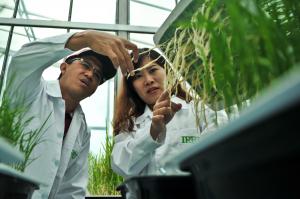The Global Methane Hub announces $30 million investment to fast-track research and development on low-emission rice
The Rice Methane Innovation Accelerator will focus on reducing methane emissions and improving water efficiency of world’s most popular staple crop.
Reducing methane emissions from all sectors is critical, not just for climate action but also for protecting global food security, and agriculture and rice farming is no exception.”
BRASILIA, SINGAPORE, November 6, 2025 /EINPresswire.com/ -- Ahead of the United Nations Climate Change Conference in Belém, Brazil (COP30), the Global Methane Hub has launched a new globally coordinated research accelerator to fast-track innovations that reduce methane emissions from rice cultivation without compromising yields and profitability.— Hayden Montgomery, director of the Global Methane Hub’s Agriculture Program
The Hub announced a $30 million commitment towards the Rice Methane Innovation Accelerator during Singapore International Agri-Food Week, and the Global Climate-Smart Agriculture Conference in Brasília, Brazil, in two countries where rice plays a significant role in diets.
The Accelerator aims to raise at least $100 million in philanthropic, public and private sector funding, and is already supported by funding from the Gates Foundation, Philanthropy Asia Alliance, Quadrature Climate Foundation, and Temasek Life Sciences Laboratory, among others. It is dedicated to expanding the suite of current options for reducing emissions, and improving resilience, focusing on four key areas of research: plant genetics and physiology, soil microbiome, agronomy, and emissions measurement.
Rice is a vital staple food for half the global population, especially in Asia, sub-Saharan Africa, and Latin America, making up to 70 per cent of daily caloric intake for millions. More than 75 per cent of rice produced globally directly serves as food for people, which is significantly higher than wheat at 66 per cent and maize at 12 per cent.
However, rice paddies, the dominant flooded system responsible for more than 90 per cent of global rice production, are a significant source of methane emissions. They account for approximately eight per cent of anthropogenic methane emissions and consume about 40 per cent of the world's irrigation water. The submerged conditions in these paddies create an oxygen-free environment where specific soil microbes flourish. These microbes consume organic matter and produce methane as a byproduct, most of which is subsequently released into the atmosphere via the rice plants.
For close to four decades, strategies like Alternate Wetting and Drying (AWD), in which fields are intermittently drained, have been promoted as ways to save water and, more recently, reduce methane emissions. However, their effectiveness is heavily dependent on local infrastructure, agronomic conditions, and the farmer's capacity to implement them. As a result, these strategies have not delivered the necessary reductions at scale to significantly bend the curve of rice methane emissions.
Without new low-emission strategies that are adaptable across diverse contexts and able to balance productivity, water-use efficiency and sustainability with improved farmer resilience, rice methane emissions could increase by an estimated seven per cent by 2030.
“Methane is a powerful but short-lived greenhouse gas. Reducing methane emissions from all sectors is critical, not just for climate action but also for protecting global food security, and agriculture and rice farming is no exception,” said Hayden Montgomery, director of the Global Methane Hub’s Agriculture Program.
“But the transition to low-emissions agriculture cannot come at the expense of food production and livelihoods. The Rice Methane Innovation Accelerator aims to give farmers new, viable options, suitable for their growing conditions and cultures, to grow rice with lower methane emissions, while saving water and building resilience.”
The Accelerator strategy, expected to be released in early 2026, will develop a roadmap for improving the readiness and real-world performance of various solutions identified under the four key research areas for rice systems.
The development of this roadmap will be assisted through the support of The Rockefeller Foundation with a convening to be hosted at its Bellagio Center, which has a long history of convening the very best in their fields to solve the world’s most pressing problems. In 2026, leaders in innovation, policy, emissions measurement, finance, philanthropic, and private sectors will meet at The Rockefeller Foundation Bellagio Center to collaborate and identify solutions that can scale impact across the rice ecosystem.
The outputs of this work will complement existing mitigation solutions including the AWD method, which was developed by the International Rice Research Institute (IRRI) and has demonstrated an emissions reduction potential of 30 to 70 per cent.
“Rice is one of the world’s most important crops, and is deeply embedded in cultural, social, and economic traditions. Farmers urgently need new tools and methods to adapt to new conditions and improve the sustainability of cultivation,” said Dr. Yvonne Pinto, Director General of the International Rice Research Institute.
“The Rice Methane Innovation Accelerator is an exciting new investment which will enhance and support the existing research ecosystem for sustainable rice production.”
The existing research ecosystem includes other specialist rice research centres like AfricaRice and The Alliance of Biodiversity International and CIAT, as well as national agricultural research institutes and universities involved in the Global Research Alliance on Agricultural Greenhouse Gases.
The Accelerator is the Global Methane Hub’s second flagship research initiative under its agriculture program after its Enteric Fermentation Accelerator, which focuses on reducing livestock emissions.
Donna Bowater
Marchmont Communications
donna@marchmontcomms.com
Legal Disclaimer:
EIN Presswire provides this news content "as is" without warranty of any kind. We do not accept any responsibility or liability for the accuracy, content, images, videos, licenses, completeness, legality, or reliability of the information contained in this article. If you have any complaints or copyright issues related to this article, kindly contact the author above.

